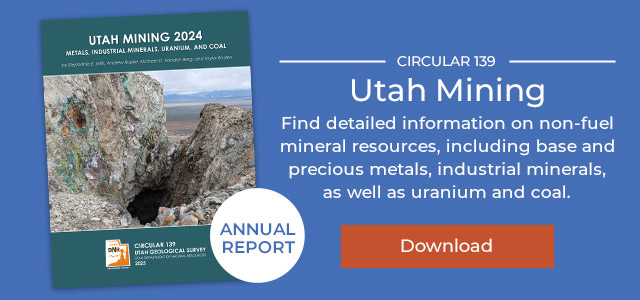Metals
Utah has a rich history in mining metals that has been integral to the development of the state since the 1860s. The total historical value of metal mining in the state is valued at over $215 billion, placing Utah as the third largest metal-producing state in the United States. Major mining districts in the state include the Bingham Canyon, Tintic, Park City, Iron Springs, Lisbon Valley, Mercur, and Spor Mountain districts, all of which have produced over $2 billion from metals mining. The Bingham Canyon district alone has produced approximately 80 percent of Utah’s total historical metal production value. Ranked in order by the most valuable metals for Utah are:
- copper (+$100 billion),
- gold, molybdenum, silver, lead, and iron ($5–55 billion),
- zinc, uranium, beryllium ($1–5 billion), and
- vanadium, manganese, and tungsten ($5–150 million).
Copper is the most valuable mined commodity in the state, making Utah the second-highest copper-producing state, behind Arizona, in the U.S.
Modern mining has its roots in Utah when in 1906 Daniel C. Jackling made the decision to mine the Bingham Canyon copper mine using open-pit methods and utilizing steam shovels and railroad. This marked a major departure from the traditional mining methods which had focused on small but high-grade deposits (such as veins) and is characteristic of copper mining all over the world today, which focuses on low grade but high tonnage deposits. Jackling’s methods made Bingham Canyon the largest industrial mining complex in the world by 1912, and to date, it is the largest manmade excavation in the world. Bingham Canyon has also been recognized as the world’s deepest open-pit mine. Bingham Canyon is primarily known for its copper production, but also produces molybdenum, gold, and silver (in the past it also produced lead and zinc). Bingham has consistently been and remains to this day a world-class copper mine and the most productive mining district in the United States.
Utah also has other nationally and globally important metal mining operations including base and precious metals, energy minerals, and critical minerals. Utah is the third-largest producer of uranium, historically, and hosts the only operating uranium-vanadium mill in the United States, the White Mesa Mill near Blanding. Utah is the world-leader in beryllium production, with historically up to 85 percent of global beryllium supply mined from the Spor Mountain mine in Juab County. Utah also ranks fifth in the United States for iron ore production, and is one of the only states to have produced germanium and gallium.
Metal Resources
The information below includes brief descriptions of some of Utah’s metal resources and helpful references or articles about those resources. If you would like to speak to a geologist about Utah’s metals, please contact Stephanie Mills at smills@utah.gov or 801-537-3308. Use the arrows to scroll through Utah’s metals.
Utah Core Research Center
The Utah Core Research Center (UCRC) contains the region’s only publicly available and most complete collection of geologic cuttings and core from Utah. The facility currently holds cuttings from approximately 5,400 drill holes; core samples from more than 1,500 drill holes; a collection of type oils from all producing formations in the state; and miscellaneous samples of metallic minerals, industrial rocks and minerals, tar sands, and oil shale. More Information.



















